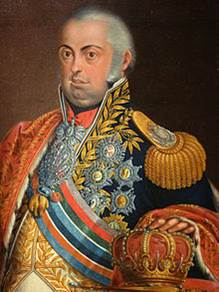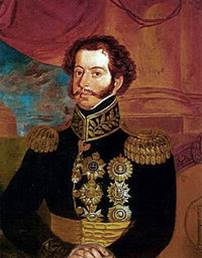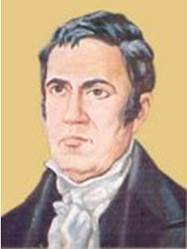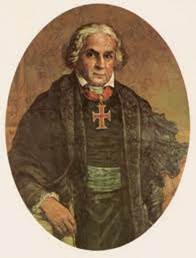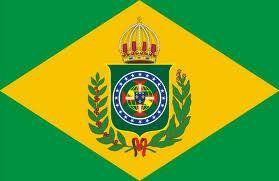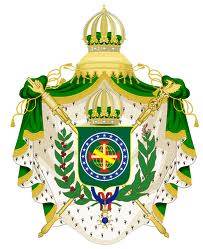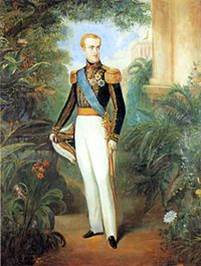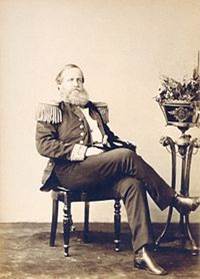By Catherine Johnson
The independence of Brazil comprised a series of political events that occurred between 1821-1824. Most of these events involved disputes between Brazil and Portugal regarding the call for independence presented by the Brazilian Empire. In 1820, the Constitutional Revolution erupted in Brazil. It resulted in the meeting of the Cortes, Constituent Assembly, which would have created the kingdom’s first constitution. At the same time, the Cortes demanded the return of King Dom Joao VI, who had been living in Brazil since 1808. In 1821, King Dom Joao VI nominated his son, Dom Pedro, as regent upon his return to Europe.
*King Dom Joao VI
The Portuguese military officers headquartered in Brazil were sympathetic to the Constitutional movement in Portugal. The main leader, General Jorge Avilez, forced the prince, Dom Pedro, to dismiss and banish the ministers of Kingdom and Finance. Both of these men were loyal allies to Pedro.
*Dom Pedro I
Meanwhile, the Cortes approved a decree that placed provincial governments directly under control of Portugal. However, dissatisfaction over this measure rose among the residents of Brazil. Two groups of opponents formed from this. These groups included the liberals led by Joaquim Ledo and the Bonifacians led by Jose Bonifacio de Andrada.
*Joaquim Goncalves Ledo
*Bonifacio de Andrada
Pedro’s support gradually shifted to the Brazilian cause after Pedro’s decision on January 9th, 1822 to defy the Cortes, men led by Jorge Avilez rioted before concentrating on Mount Castelo. Dom Pedro then dismissed the Portuguese commanding general and ordered him to remove his soldiers. Jose Bonifacio was nominated minister of Kingdom and Foreign Affairs on January 18, 1822 and soon established a close relationship with Pedro. Gonclaves Ledo and the liberals tried to minimize the close relationship between Bonifacio and Pedro by offering the title of Perpetual Defender of Brazil. For the liberals, the meeting of a Constituent Assemble for Brazil was necessary, while the Bonifacians preferred that Pedro grant the constitution himself. Pedro agreed to the liberal’s request and called for an election of the deputies that would gather in the Constituent & Legislative General Assembly in Brazil. Pedro departed to Sao Paulo Province to assure that province’s loyalty to the Brazilian cause. Upon his return, September 7, 1822 he learned that the Cortes had removed the remaining power Pedro still had. Pedro turned to his companions and said:
“Friends, the Portuguese Cortes want to enslave and pursue us. From today on our relations are broken. No ties unite us anymore… Hail to the independence, to freedom, and to the separation of Brazil…For my blood, my honor, my God, I swear to give Brazil Freedom Independence or Death!”
The news of independence quickly spread throughout the country and Pedro, received with great popular celebration, was called “King of Brazil.” It was quickly decided that Pedro should be named Constitutional Emperor, a new flag and arms were created, and on September 22, 1822, Brazil officially claimed its independence.
*Flag of the Empire of Brazil
*Coat of Arms of the Empire of Brazil
The war between the Brazilians and Portuguese lasted from February 1822 to November 1823. There are still no reliable statistics related to the number of casualties. However, based on historical registration and contemporary reports total number of deaths is estimated to be around 5,700 to 6,200. Unlike most of its Hispanic republic neighbors, Brazil has political stability, freedom of speech, respect for civil rights and vibrant economic growth. Its bicameral parliament, Assembleia Geral, was elected under comparatively democratic methods for the era, as were the provincial and local legislatures. Pedro’s successor, in 1831, was his 5 year old son, Pedro II, and a weak regency was created. The absence of a ruling monarch led to regional civil wars between local factions. However, once of age, Pedro II managed to bring peace and stability to the country, which eventually became an emerging international power.
*Emperor Pedro II
*Emperor Pedro II
With prosperity and economic development came an influx of European immigrants, including Protestants and Jews, although Brazil remained mostly Catholic. Slavery, which had initially been widespread, was restricted by successive legislation until its final abolition in 1888. Brazilian visual arts, literature and theater developed during this time of progress. Much of this had European Influence but had a Brazilian twist. Despite the fact the last 4 decades of Pedro II’s reign were marked by continuous internal peace and economic prosperity, he personally had no desire to see the monarchy survive beyond his lifetime. On November 15, 1889, after a 58 year reign, the Emperor was overthrown in a sudden coup d’état that had almost no support outside a clique of military leaders whose goal was the formation of a republic headed by a dictator.
